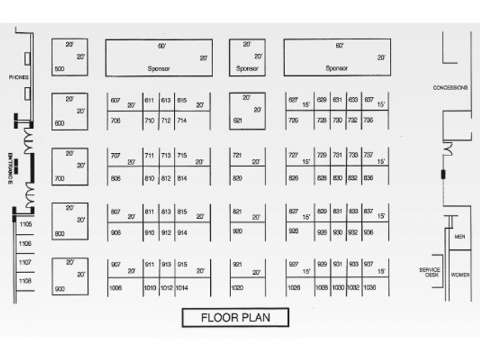ExhibitorEase Guide: Choosing the Right Location [1]

The location of your booth in the exhibit hall is critical to your ability to draw qualified visitors. Each show hall is unique in its dimensions and configuration, so try to visit the hall prior to choosing your space. If visiting the hall is impractical, ask show management for a copy of the floor plans. Be sure to ask if the plans indicate blind spots or columns or poles that may interfere with visibility.
Section 2: CHOOSING THE RIGHT LOCATION
THINK ABOUT . . .
- Elevators & Escalators
- Entrances & Exits
- Food Areas
- Stage & Seminar Sites
- Competitors
- Restrooms
The decision on where to place your booth depends on many factors. How much traffic can your sales team handle effectively? What is the size and purpose of your booth? Where is the competition located? Do you need additional space for storage or demonstrating products? Study the floor plan carefully and ask the show manager for assistance if the plans are confusing.
Typical Space Layouts
Aisle (also known as in-line or linear)
Only one side faces the aisle
![]()
Peninsula
Surrounded by aisles on three sides

Island
Surrounded by aisles on four sides
![]()
BE ALERT TO . . .
- Obstructions
- Late Set-Up Areas
- Dead-End Aisles
- Loading Zones
- Dimly Lit Areas
- Noisy Areas Near a Stage or Demonstration Area
To determine your space requirement
- Estimate how may visitors will pass by your booth during a busy hour by verifying the show’s potential audience size and dividing that number by the total show hours. Check with the show management for statistics.
- Realistically, how many visitors per hour do you expect to engage? On average, each sales rep can speak effectively with up to 15 visitors per hour.
- Allow 50 square feet of space per staff member. (Industry Standard)
- Determine the space required for displays and demonstrations, then add the number of staff for your total square footage.
Once you specify the requirements for the display and configuration of your booth, you will be better prepared to choose a location that will help you achieve your trade show goals. Remember to allow enough space for visitors to browse, and for product demonstrations, if necessary.
Sections
Section 1: Planning for the Show [2]
Section 2: Choosing the Right Location [1]
Section 3: Choosing the Right Display [3]
Section 4: Attracting Visitors [4]
Section 5: Promotional Giveaways [5]
Section 6: Exhibitor Sales Techniques [6]
Section 7: Managing Leads [7]
Section 8: Exhibition Services [8]
Section 9: Shipping [9]
Section 10: Common Exhibitor Mistakes [10]

